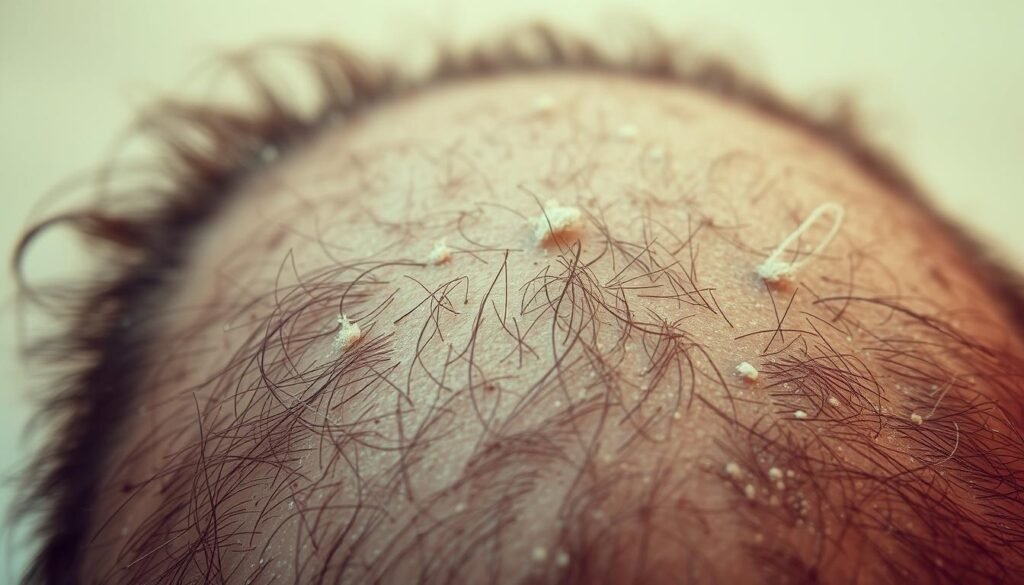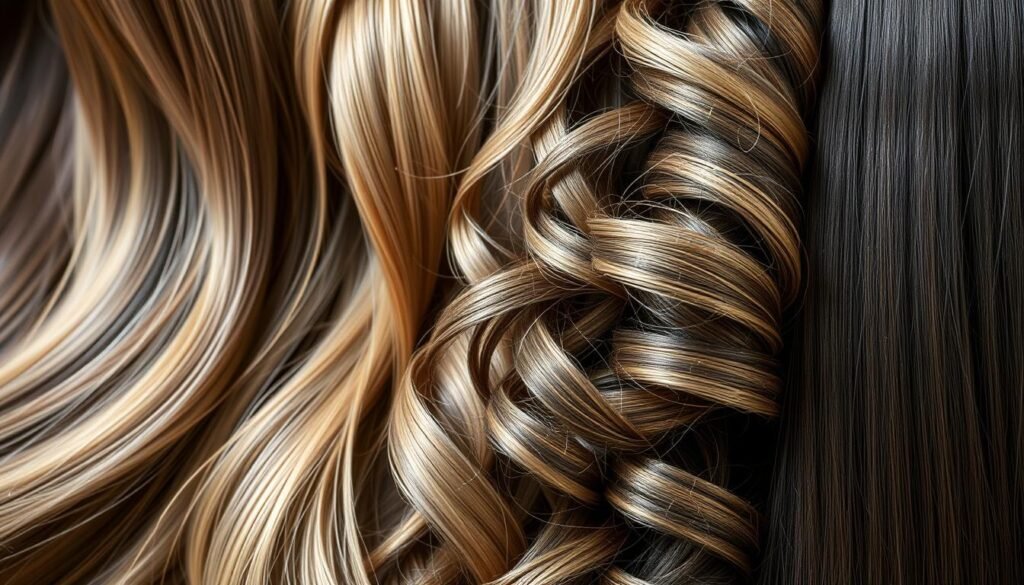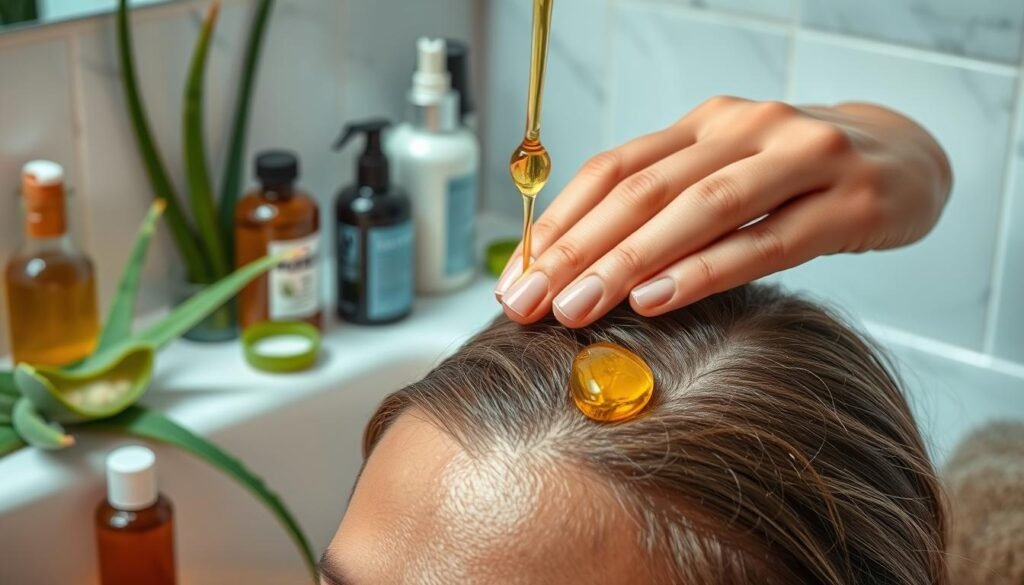Did you know the EPA suggests keeping indoor humidity levels between 30 and 50 percent? This is important because 90% of Americans are mostly indoors. Here, the right moisture levels are crucial for health, including our scalp’s wellbeing. Low humidity is often in winter and dry places, causing scalp and hair problems.
The dryer the air, the less moisture it can hold, which affects our scalp skin. This might lead to a dry scalp, more sensitivity, and itchiness. This article looks into how low humidity impacts scalp health. We will share insights on symptoms, causes, and how to treat them. Knowing this helps us care for our scalp better, improving hair health too.
Key Takeaways
- Low humidity can cause dry scalp, irritation, and discomfort.
- Indoor humidity levels are key for good scalp health.
- Itchiness and dryness are common when humidity is low.
- Knowing why dry scalp happens can aid in preventing it.
- There are effective ways to deal with scalp issues from low humidity.
Understanding Humidity and Its Impact on Hair
Humidity is about the water vapor in the air affecting hair health and look. High humidity can make hair frizzy and hard to manage. It’s crucial to note the impacts of humidity on hair for good hair care. Both too much and too little humidity challenge different hair types.
Curly or high porosity hair quickly takes in moisture from the air. This can cause frizziness and untidy curls. Low humidity pulls moisture out, leading to dryness. In high humidity, curly hair can puff up, get thicker, and be tough to control.
Fine or low-porosity hair behaves in the opposite way. They can go limp and flat in medium to low humidity. These hair types don’t absorb moisture fast. This makes them lose body and shine in low humidity. It’s key to adjust your hair care based on these facts for healthy, lively hair.
Using products like Rossano Ferretti Parma helps with these issues. They have items for all hair types to stay hydrated and fight humidity. For example:
| Product Line | Perfect For | Benefits |
|---|---|---|
| Dolce Collection | All hair types | Deep moisture, manageable hair |
| Intenso Collection | Thick and curly hair | Strength and protection |
| Favoloso Serum | Defined curls | Enhanced curl definition |
| Velluto Serum | Sleek straight hair | Humidity control, frizz reduction |
| Brillante Oil | All types | Frizz-free hair, UV protection |
| Prodigio Oil | Split ends and frizz | Moisturization and protection |
These products avoid harsh chemicals and are cruelty-free and vegan. They’re great for anyone wanting top hair care without harm. Knowing how humidity and hair interact helps in getting beautiful, strong hair.
How Low Humidity Affects Scalp Health
Low humidity brings many challenges for scalp health, especially with changing seasons. As moisture drops, it impacts scalp hydration. A dry scalp isn’t only uncomfortable; it leads to problems for many people.
Effects on Moisture Levels
When autumn arrives, humidity falls and so does scalp moisture. This can make your scalp very dry, causing flakiness and redness. Dryness increases, making hair and scalp brittle. This low humidity effect can cause flaking and irritation.
Increased Sensitivity and Irritation
Moisture loss makes the scalp more sensitive to irritants. This sensitivity can cause a lot of scalp irritation, troubling your daily life. Scalps may react badly not just to climate but also to hair products used in summer. It’s important to tackle these problems early. Otherwise, low humidity weakens scalp defenses, leading to infections and other issues.
The Connection Between Low Humidity and Dry Scalp
Low humidity can really affect our scalp’s health, leading to discomforts. If you have a dry scalp, you might feel itching, notice flaking, and experience irritation. It’s key to spot these dry scalp symptoms early on for the right treatment.
Symptoms of a Dry Scalp
If your scalp is dry, you may:
- Feel Itching, from mild to intense.
- See flakes or dry spots on your scalp, which can be quite embarrassing.
- Experience redness or irritation in some cases.
These issues can make you feel uncomfortable and less confident. So, it’s crucial to address them.
Common Causes of Dry Scalp in Low Humidity
Dry scalp is often more common in places with low humidity causes. The usual culprits are:
- Indoor heating during winter, which produces hot air.
- Not moisturizing enough, which leaves the scalp dry.
- Washing hair too much, stripping away natural oils.
- Cold air exposure and other environmental factors that worsen dry hair conditions.
To improve scalp health, change up your hair care routine. Use products that hold in moisture. Try hydrating hair masks with aloe vera or olive oil. They can bring back moisture and prevent problems down the line. For more tips on keeping your scalp healthy, here’s a good resource.
| Dry Scalp Causes | Possible Solutions |
|---|---|
| Low humidity | Use humidifiers |
| Overwashing hair | Reduce hair washing frequency |
| Heat from styling tools | Avoid excessive heat usage |
| Environmental irritants | Switch to hypoallergenic products |
Low Humidity’s Role in Itchy Scalps
An itchy scalp often gets worse with low humidity. This usually happens because the skin gets dry. This dryness can then cause irritation and flaking. Understanding this can help us find ways to prevent it.
Understanding Itch Sensation Mechanisms
When the air is dry, our scalp loses moisture. This makes the scalp dry and uncomfortable. Besides, things like rough hair products make it worse. But, using products with ingredients like aloe vera can help soothe the scalp.
Prevention Strategies for Itchy Scalps
To keep the scalp from getting itchy, it’s important to act early. Using moisturizing shampoos can bring back the needed moisture. Massaging the scalp regularly also helps by improving blood flow.
A good hair care routine should include treatments that keep the scalp hydrated. Eating well also plays a part in keeping your hair and scalp healthy. For more tips, check ways to combat moisture-related hair issues.

By choosing the right scalp care methods, itchiness can be greatly reduced. It’s key to use the right products and eat a balanced diet.
Dandruff: A Common Issue in Dry Conditions
Dandruff becomes more noticeable in dry weather. People often face more dandruff issues when the air is dry. Knowing the types of dandruff caused by low humidity helps choose the best treatment.
Types of Dandruff Related to Low Humidity
In dry seasons, two main types of dandruff appear: dry skin and oil-related. Dry skin dandruff means your scalp is too dry, causing flakes. Oil-related dandruff is due to too much oil and a fungus called Malassezia. This mix causes itching and flakes, especially when it’s cold or when using indoor heating.
Effective Treatments for Dandruff
To tackle dandruff, combine moisture and fungal control. There are many ways to ease dandruff symptoms:
- Medicated shampoos with zinc pyrithione and salicylic acid fight fungus and flakes.
- Use conditioners regularly to keep moisture and ease irritation.
- Drink plenty of water and wash your hair with warm water to avoid dryness.
- Try products with tea tree oil for extra antimicrobial and anti-inflammatory effects.
By using the right strategies, you can keep your scalp healthy and manage dandruff in dry conditions.
Effects on Hair Texture and Manageability
Low humidity can make your hair frizzy and lead to breakage. Your hair loses vital moisture when the air is dry. This leaves it looking rough and hard to manage. Tight curls and coils get hit the hardest. They need extra care to keep their shape and health.
Impact on Hair Frizziness and Breakage
Frizziness gets worse in cold months because hair dries out. Washing your hair every 7 to 10 days helps fight the dryness. Co-washing around day four keeps natural hair hydrated. But, be careful not to over-moisturize. This can cause hygral fatigue, making hair weak and prone to breakage. Keeping moisture balanced is key to healthy hair.
Solutions for Maintaining Hair Health in Low Humidity
There are good ways to deal with low humidity and hair health. It’s smart to use conditioners and products made for your hair type. Brands like Design Essentials, Congo, Pattern, and Flourish have great options. The L.O.C method works wonders for tight curls. Looser curls do well with light lotions or leave-ins, then some oil.
- Try using a hair steamer in winter to boost moisture.
- Use silk and satin things to cut down on friction and keep moisture in.
- Choose protective styles, like braids or wigs, and look after your scalp to avoid breakage.
By doing these things, you can keep your hair healthy, less frizzy, and reduce breakage when it’s dry out. For more tips on scalp care and treatments, check out this useful link.

Static Electricity and Its Relationship with Low Humidity
In the winter, static electricity becomes a big problem. Low humidity and friction from materials like wool make it worse. When hair loses or gains electrons, you get unwanted flyaways. This not only looks bad but can also damage hair over time.
What Causes Static Electricity in Hair
When humidity is low, hair gets drier and more static-prone. Certain products can help. Look for items with glycerin and coconut oil; they keep hair moist. Also, use less plastic on your hair. Brushes with natural bristles or wooden combs create less static.
How to Combat Static Hair Issues
To fight hair static, start by keeping indoor humidity at 30-50%. A humidifier can make a big difference. Also, use less heat on your hair. Try air drying or cooler settings. Moisturizing shampoos and scalp massages keep hair hydrated, reducing static.
Another tip is to use anti-static dryer sheets in your hair care. They can offer extra protection against static.
For more help with hair static in winter, check out this useful guide.
Protecting Your Scalp and Hair from Low Humidity
In colder months, it’s key to keep hair and scalp moisturized because humidity drops. A proactive approach helps fight off dry air’s bad effects, like itchiness and hair damage. Using the right treatments and picking proper hair care products can improve scalp defense and hair quality.
Importance of Deep Moisturizing Treatments
Deep moisturizing treatments are huge for adding back lost moisture and fighting dryness. Using moisturizing products often can help the scalp feel better and make hair healthier. Ingredients like pure olive oil can lock in moisture and give dry, brittle hair a nice shine. These treatments also lessen itchiness and create a better scalp environment.
Choosing the Right Hair Products
It’s crucial to choose the right hair care products to avoid losing moisture when there’s low humidity. Look for shampoos and conditioners with moisturizing ingredients like hyaluronic acid and others. They can nourish the scalp and fight dryness while also keeping it safe. Avoid washing your hair too much and using high heat when styling. These can take away important oils and make dryness worse. Wearing protective styles like braids or updos can protect hair from bad weather. This helps keep the moisture in and stops hair from breaking.

Best Practices for Scalp Health During Dry Conditions
Keeping your scalp healthy during dry times is key for strong hair. By following certain steps, you can fight the negative effects of low humidity. Keeping your scalp moist and well-fed is crucial.
Hydration and Nutrition Tips
Drinking six to eight glasses of water per day is important. This keeps your scalp from getting dry. Eating foods high in vitamins A, E, and B helps your scalp’s health. This also supports hair growth and makes your hair better overall.
Adding foods with zinc and iron is good for your scalp too.
Consistent Scalp Care Routine
A regular scalp care routine helps a lot. Gently scrubbing your scalp gets rid of oil, dead skin, and dandruff. Using coconut oil for a 10-minute scalp massage before washing has great benefits.
Washing with gentle shampoos and using moisturizing conditioners brings back moisture. This helps fight dryness.
To really take care of your scalp, use products made for dry scalps. This includes dandruff shampoos or those with salicylic acid. For the latest scalp health tips, check out platforms like this resource.
Conclusion
Knowing how low humidity affects scalp health helps keep hair strong. It can lead to a dry scalp, itchiness, and dandruff. These issues are worse in certain environments. Spotting these signs early is key to caring for your hair properly.
Keeping your scalp healthy is crucial. You need a good hair care plan that fits the weather. Stay hydrated, protect your hair from damage, and pick the right products. This will make your scalp healthier and your hair look better. Acting fast against low humidity problems is important for great-looking hair.
Being aware and caring for your scalp makes a big difference in hair health. Use the right treatments, adapt to the weather, and focus on keeping your scalp strong. These actions lead to healthier hair.